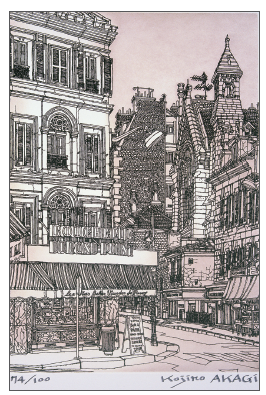Rue de la Pompe / Rue de la Pompe / ポンプ通り
Dublin Core
Title
Rue de la Pompe / Rue de la Pompe / ポンプ通り
Subject
Eau-forte, Rue
Description
Derrière la mairie du 16e, cette rue commerçante, fréquentée par les résidents, a été préservée depuis l’époque où le quartier n’était qu’un village. Elle n’est plus en accord avec les résidences bourgeoises haut de gamme. Le clocher que l’on voit au loin appartient à l’église de la mission catholique espagnole construite en 1898. L’écrivain Julien Green, né en 1900, dont les parents américains avaient immigré en France, parle de cette église dans ses romans. Cette histoire est connue des amateurs de littérature moderne. Le lycée Janson de Sailly, fondé en 1881 dans cette même rue, est un établissement réputé qui a formé de nombreuses célébrités. Il a été inauguré par le président de l’époque, Jules Ferry, qui a établi la séparation de l’Église et de l’Etat, la gratuité de l’éducation et la laïcité dans l’enseignement. Dès 1925, l’Ambassade du Japon se situait à côté de ce lycée, où elle est resté jusque dans les années 60.
At the back of the public office of the 16th arrondissement, there is a central street left over from the bygone era of small villages era. It doesn’t sit well along- side the luxurious residences hereabouts. People in the neighbourhood visit the shops there. The distant bell tower is the church of the Spanish Catholic mission, built in 1898. Julien Green, a writer born in 1900 whose parents immigrated from the USA, wrote about this church so it is familiar to those who read contemporary literature.On the same street not too far away is the Lycée Janson de Sailly, a high school founded in 1881. The President at that time, Jules Ferry, was invited to break the ground for the building. It was he who established the principles of separation of government and religion, free primary education for all and secularisation of the education system. This is a prestigious institution from which many famous people have graduated.From 1925 the Japanese Embassy, upon reopening after the World War II, stood near this school until the middle of the 1960s.
十六区役所の裏に、豪華なお屋敷街の建物に似つかわしくない、古い昔の村落時代からの中心通りが残っていて、商店が集まり、土地の人が買い物にくる。遠くの鐘楼は、一八九八年に建てられたスペイン系カトリック・ミッションの教会堂である。両親はアメリカからフランスに移住の一九〇〇年生まれの作家ジュリアン・グリーンは、この教会堂のことを書いていて、現代文学の人には知られている。 同じ通りの、近くにある一八八一年創立ジョンソン・サイール高校は、当時の大統領でフランスの政教分離、初等教育無償、非宗教の教育原則を確立したジュール・フェリー大統領によって鍬入れ式を行われ、有名人を沢山出している名門高校である。一九二五年以来、第二次大戦後も引き続き再開の、日本大使館も、一九六〇年代半ばまで、この学校の近くにあった。
Creator
Kojiro Akagi (1934-2021)
Date
Mai 1994, May 1994
Rights
Fonds de dotation Kojiro AKAGI
Format
Eau-forte, Atelier Garric Tanguy, 100 tirages + 6 E.A. romain,
sur papier Arches 30,5 x 43,5 cm.
sur papier Arches 30,5 x 43,5 cm.
Type
Eau-forte
Citation
Kojiro Akagi (1934-2021), “Rue de la Pompe / Rue de la Pompe / ポンプ通り,” Kojiro Akagi - Fonds de dotation Kojiro AKAGI , accessed January 5, 2026, https://kojiroakagi.com/gallery/items/show/121.

